Timeless ascent
On 05 October, Orianne and Louis had the opportunity to meet Mattias Baumüller, director of the stonemasons' lodge of the Regensburg cathedral. They lived a visit of more than 6 hours, they share this exceptional experience with you!
LOGBOOK
Orianne Pieragnolo
11/10/20224 min read
Il est 10 h 30, lorsque nous arrivons avec nos vélos chargés dans la ville de Regensburg (Ratisbonne pour les français). Ce matin-là, nous garons nos bolides au pied de la cathédrale. Devant l’atelier des tailleurs de pierre. Au premier regard, il ressemble à une maison champêtre, qui nous amène loin de la ville. Un jardin planté de pierres taillées et de pots de fleurs entourent les murs en moellons qui nous accueillent chaleureusement. Tout comme son Leiter de la Domebauhütte*, Matthias Baumüller.Regard perçant et sincère, fervent passionné de son métier et de “sa” cathédrale. Matthias s’apprête à nous faire vivre l’une des plus belles visites de notre vie. Un voyage dans le voyage. Six heures et trente minutes continues, qui nous mènera à découvrir de multiples recoins de la cathédrale.
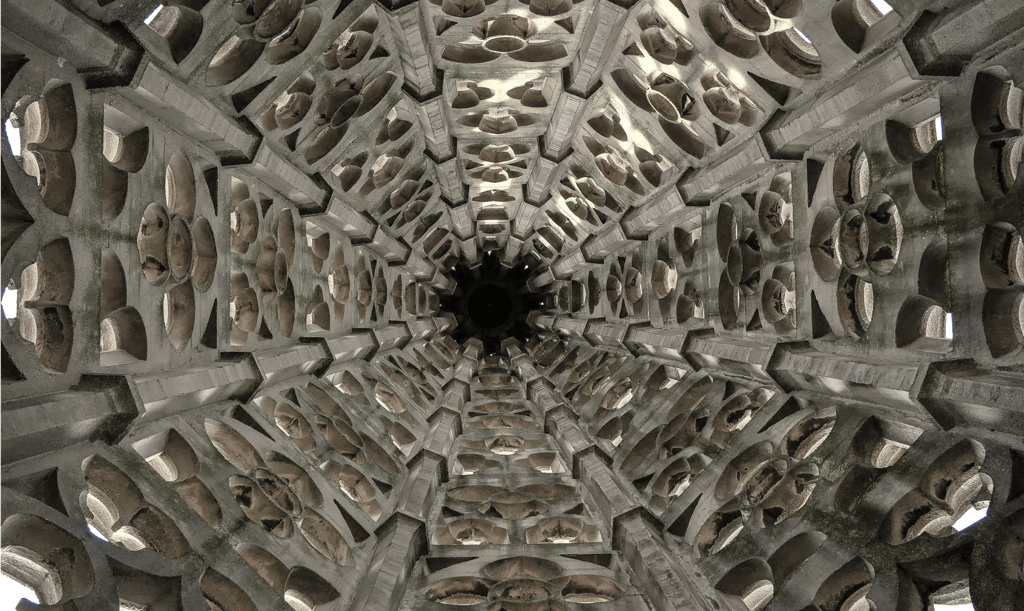


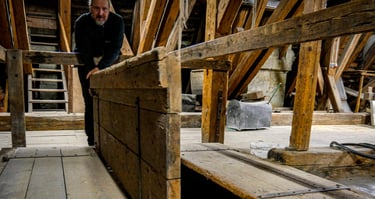


The cathedral can be seen as a symbol and an elusive architectural object. It concentrates within itself a force that both fascinates and disconcerts us. Planted in the centre of our cities, it can be compared to a remarkable natural entity, venerated by certain peoples. In this construction, Man has deployed an extraordinary energy. It is still engraved in these walls and we marvel at it. A milky way of details, time and unity that allowed the construction of a sacred place, made of beliefs and imaginations. On October 5, 2009, the fortunate chance of a journey took us to Regensburg Cathedral, where we ventured to capture a few snippets of it.
After a few minutes, recovered from our emotions, we approach the walls of the spire. They were restored in cement at the end of the 20th century. This makes us wonder about the restoration methods. We discuss it at length. But the reflection leads us to our position as stonemasons. On our role in the construction. The two spires were completed at the end of the 19th century, completely changing the silhouette of the building and completing six centuries of projects and work. Since then, the hands of craftsmen have been busy restoring it. To preserve it as such. When it has always absorbed and been shaped by the influences and assemblages of thousands of people, how is it possible that this effort has been stopped? It would be seen as blasphemy to build a new project within it.
We are now becoming nurses rather than builders. For us, Regensburg Cathedral was a mirror. A slap in the face of our predecessors. They left us with the essence of their building spirit. So when will the stonemasons come back to tease out gravity?
With this article we would like to thank Matthias Baumüller and Catherine Hummel for a day that will remain in our memories forever.
As always when a stonemason becomes a guide, he will help us understand details that are often unknown to many, even to specialists and historians. So it is in the pretty building of the workshop that everything begins. The place exudes a certain calm. Matthias is calm and offers us the answers to the many questions we ask him. He takes us through the different rooms of the Bauhütte*. We see the forge, the purification room, the offices, the storerooms, the kitchen and even the archives. In the workshop, the stonemasons work by hand. They use tools considered to be from the same period as the cathedral. Here, the rule is strict. No electric machines or pneumatic tools. The hammer and chisel are the rhythm of the day. As we were about to enter the cathedral, Catherine Hummel, a French guide and lecturer, joined us: "I can accompany you, if you want, to do the translation, I am free until the end of the afternoon". Chance is definitely our friend today!
The four of us go through the first door, which Mathias opens for us. A spiral brick ramp takes us up to the top of the donkey tower. A Romanesque vestige of the building. Evidence of time and its ramifications. The doors continue to open. The passages lose us in the meanders of the cathedral. Our eyes are wide open. We are on the lookout to record the precious stream of information given by Mathias and Catherine. The hooks* surround us, the view overlooks the city and the vaults cover us like the one in heaven.
The learned geometric forms tell us about the spaces they build. Capitals, bases and ornaments are covered with human observations, grimaces, claws, buds and forms seen by Men of Craft. Are they hours of walks? Of stories? Of drawings? Certainly all of them. These touching details come to us as evidence of lived imaginations, which lead us to rethink the state of mind of another time. An attachment to natural forms and humour. A certain notion of freedom emerges. The ascent continues to the top. At the very top. On one of the spires. When we reach the last step, we fall silent. We let the silence speak to contemplate the dizzying height. 105 metres above the ground. The stones make us fly.



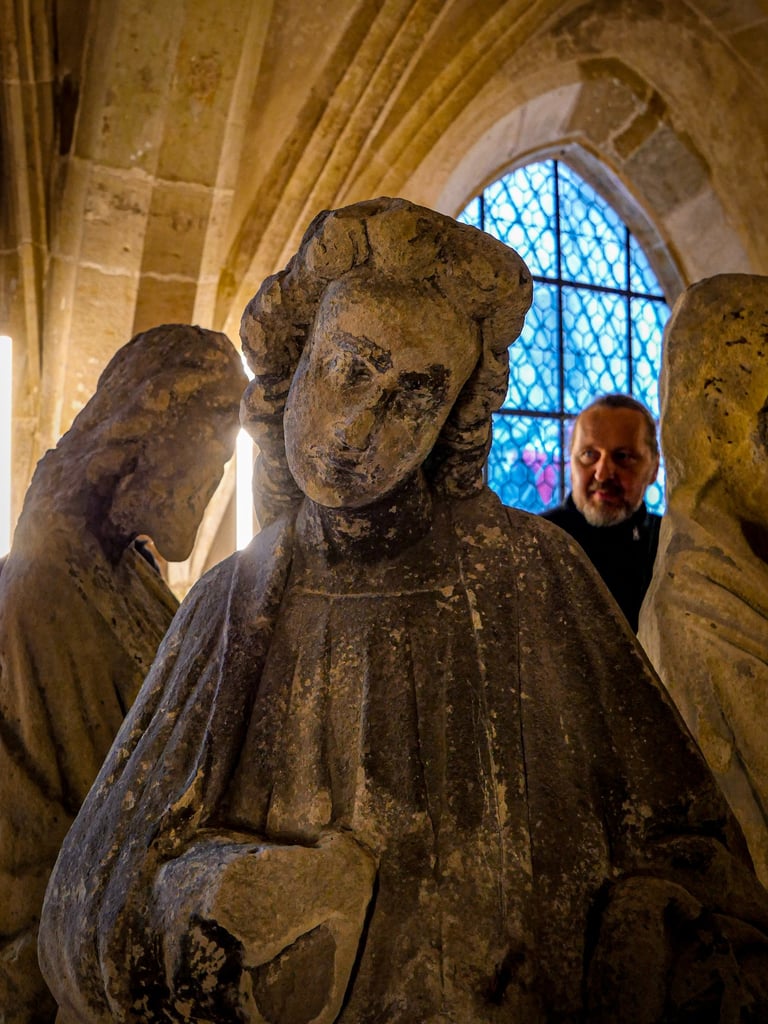
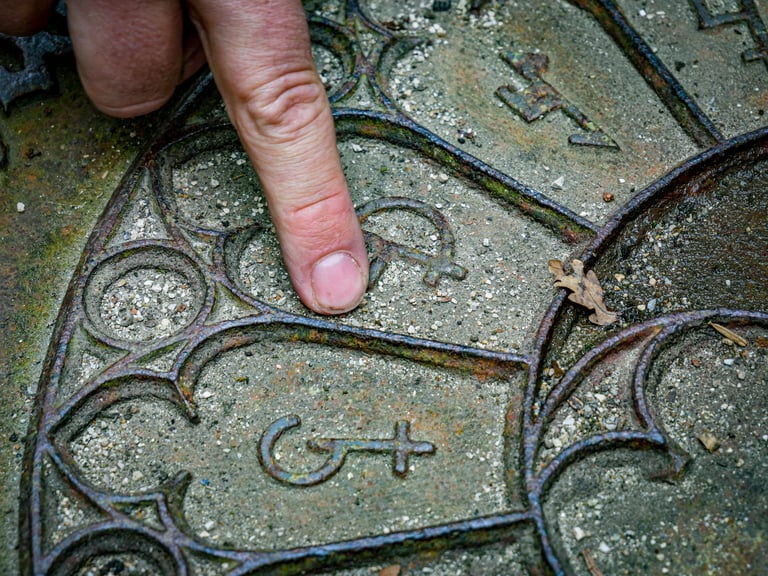

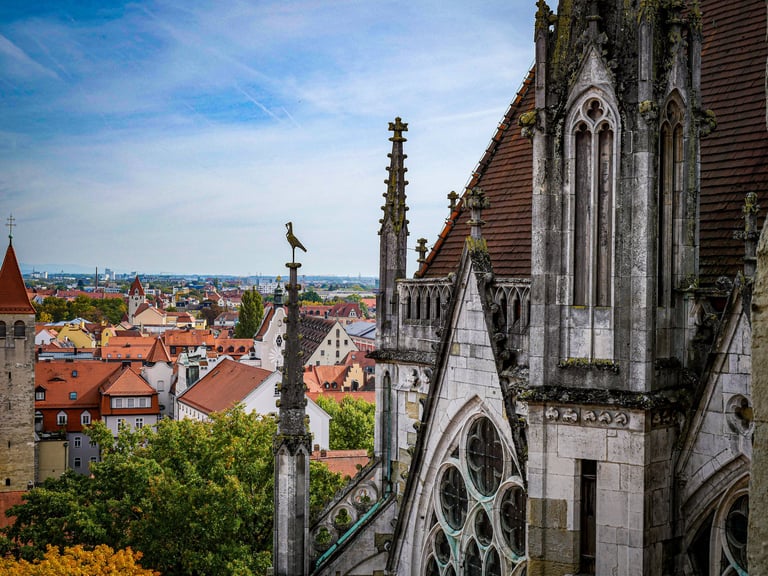









Captions from left to right and top to bottom:
View of the North Spire.
Statue room in the former monastery.
View of the cathedral bird above a finial.
Central trumeau of the cathedral's main portal.
Trademark of Mattias Baumüller.
Drawing room of the Bauhütte.
1970s plan of the cathedral.
Visit to the cathedral with Mattias Baumüller and Catherine Hummel.
Do you like our articles?
Bauhütte : Système d'atelier dédié à la restauration et la préservation de la cathédrale et des savoirs-faire des tailleurs de pierre.
Hooks: Architectural ornamentation in the shape of a cabbage or rose, widely used during the Gothic period.
Opening of the trapdoor above the nave of the cathedral
Interior view of the cathedral's south spire




Follow the project ...
Editorial by the La Route de la Pierre team
©️La Route de la Pierre | Legal Notice | Privacy Policy | General Terms and Conditions of Sale
